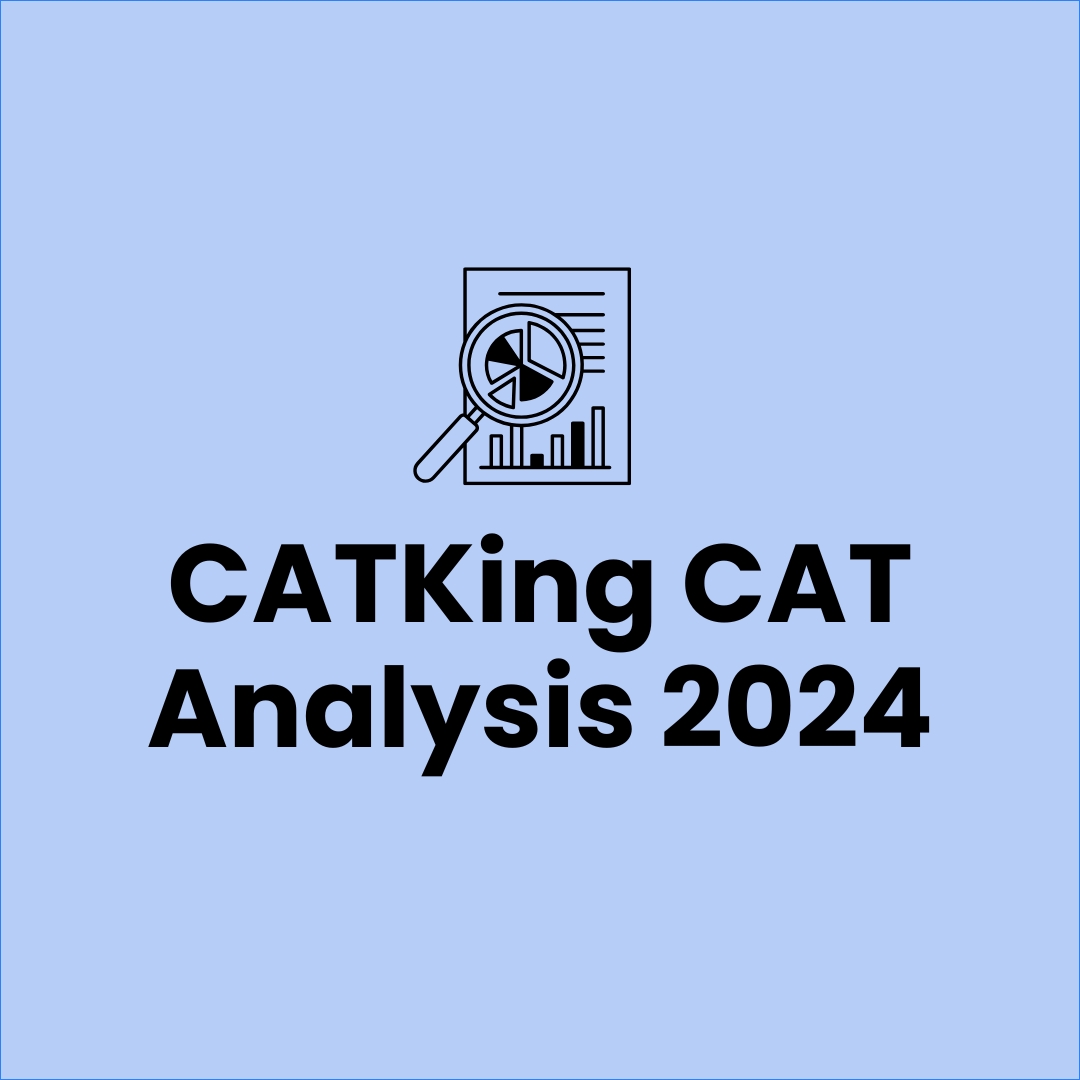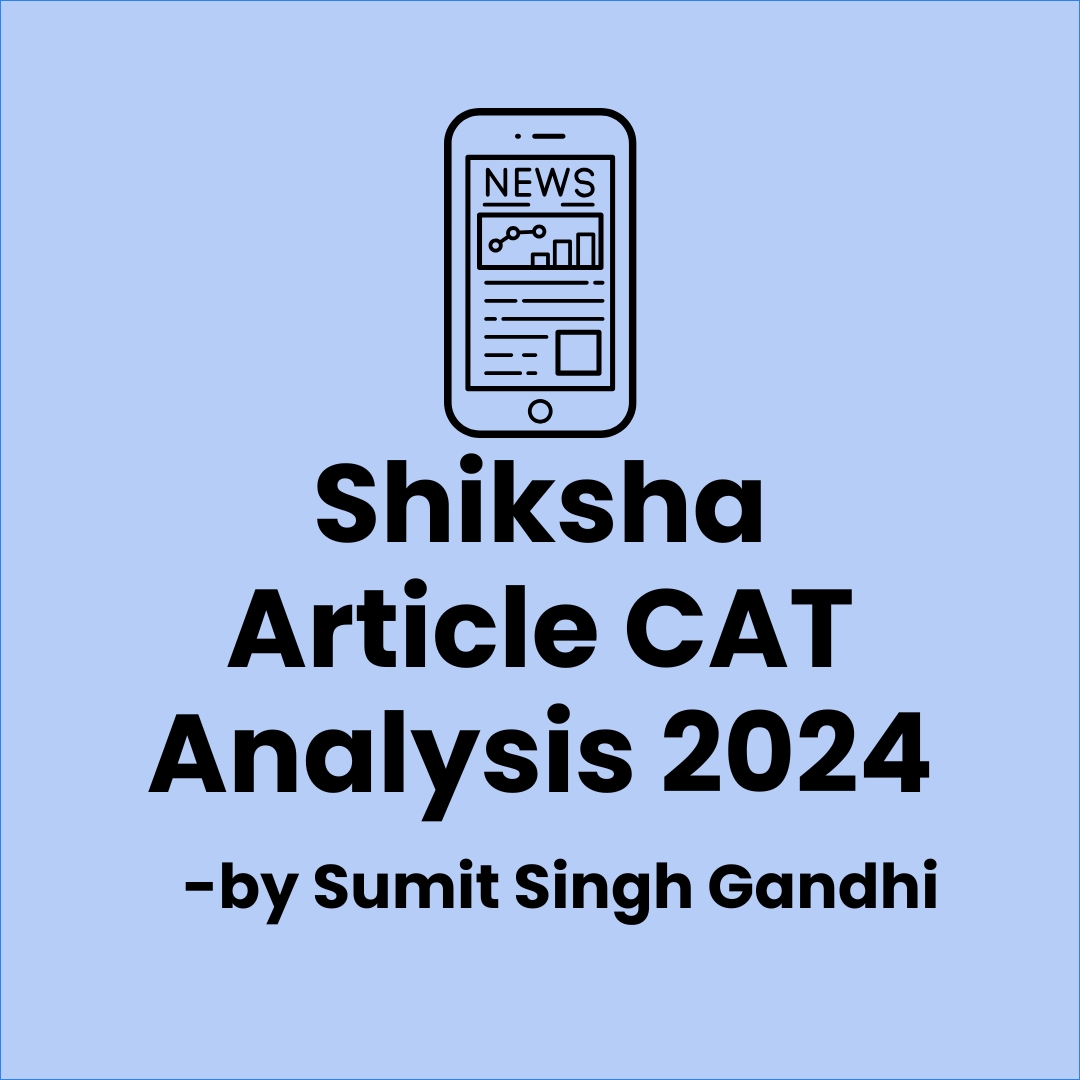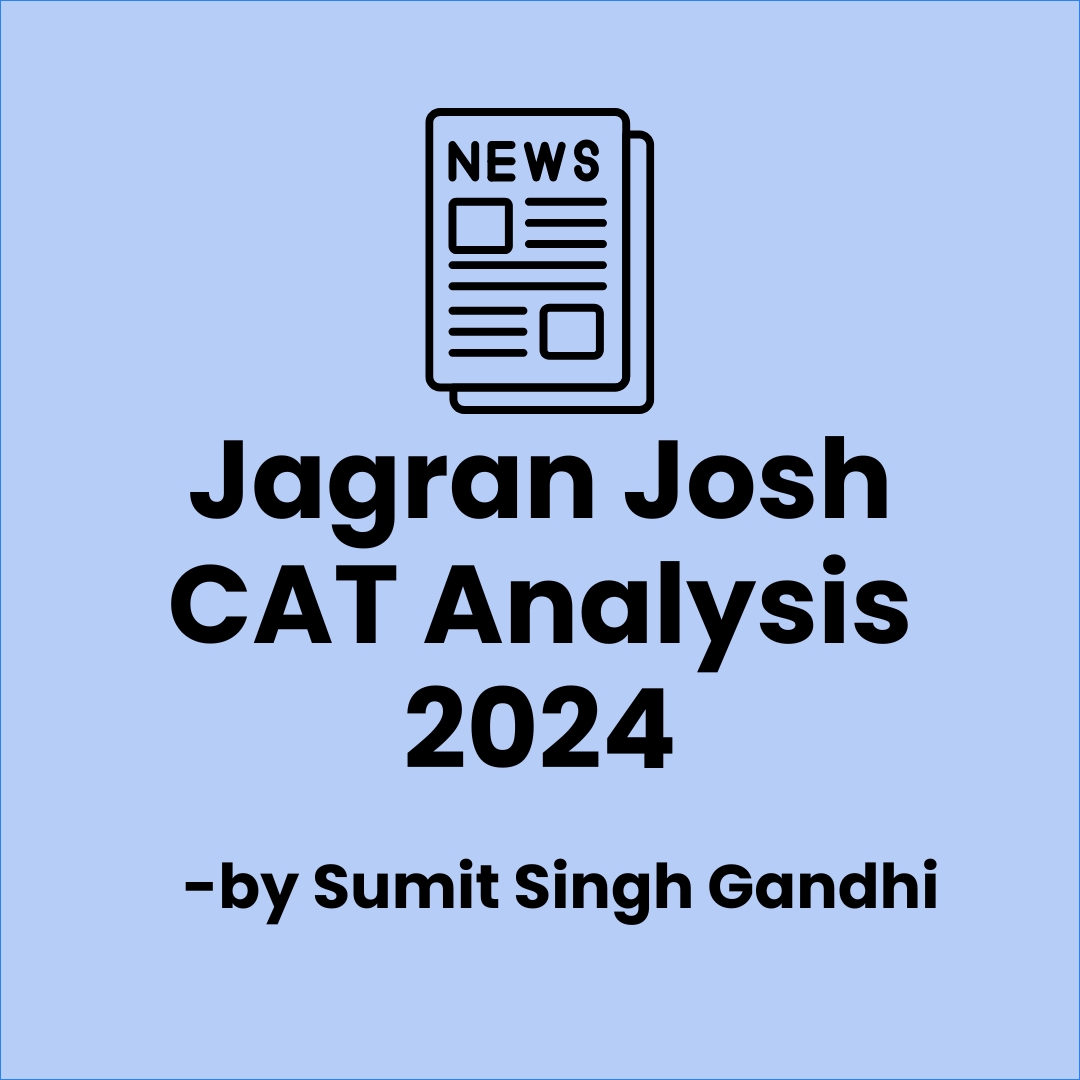
| Section | Topics | Level of Difficulty 2023 |
| Analytical Reasoning | Critical Thinking Questions | Moderate to Difficult |
| Coding-Decoding Puzzles | Moderate to Difficult | |
| Input-Output Topics | Moderate to Difficult | |
| Inference-Based Problems | Moderate to Difficult | |
| Overall | Moderate to Difficult | |
| Verbal Skills | Reading Comprehension Passages | Lengthy but Moderate |
| Grammatical Concepts | Moderate | |
| Overall | Moderate | |
| Quantitative Skills | Arithmetic | Complex Lengthy to Tough |
| Algebra | Complex Lengthy to Tough | |
| Geometry | Complex Lengthy to Tough | |
| Current Mathematics | Complex Lengthy to Tough | |
| Data Interpretation (DI) | Complex Lengthy to Tough | |
| Number System | Complex Lengthy to Tough | |
| Profit and Loss | Complex Lengthy to Tough | |
| Overall | Complex Lengthy to Tough |
| Section | Topics | Level of Difficulty 2022 |
| Analytical Reasoning | Critical Thinking Questions | Moderate |
| Coding-Decoding Puzzles | Moderate | |
| Input-Output Topics | Moderate | |
| Inference-Based Problems | Moderate | |
| Overall | Moderate | |
| Verbal Skills | Reading Comprehension Passages | Lengthy but Easy |
| Grammatical Concepts | Easy | |
| Overall | Easy | |
| Quantitative Skills | Arithmetic | Moderate |
| Algebra | Moderate | |
| Geometry | Moderate | |
| Current Mathematics | Moderate | |
| Data Interpretation (DI) | Moderate to Difficult | |
| Number System | Moderate | |
| Profit and Loss | Moderate | |
| Overall | Moderate to Difficult |
| Section | Topics | Level of Difficulty 2022 |
| Analytical Reasoning | Critical Thinking Questions | Moderate |
| Coding-Decoding Puzzles | Moderate | |
| Input-Output Topics | Moderate | |
| Inference-Based Problems | Moderate | |
| Overall | Moderate | |
| Verbal Skills | Reading Comprehension Passages | Moderate to Difficult |
| Grammatical Concepts | Moderate | |
| Overall | Moderate to Difficult | |
| Quantitative Skills | Arithmetic | Moderate |
| Algebra | Moderate | |
| Geometry | Moderate | |
| Current Mathematics | Moderate | |
| Data Interpretation (DI) | Moderate | |
| Number System | Moderate | |
| Profit and Loss | Moderate | |
| Overall | Moderate |
ATMA 2020 Analysis
Sections | No. of questions | Time Limit(minutes) | Total Marks |
Analytical Reasoning Skills – I | 30 | 30 | 30 |
Analytical Reasoning Skills – II | 30 | 30 | 30 |
Verbal Skills – I | 30 | 30 | 30 |
Verbal Skills – II | 30 | 30 | 30 |
Quantitative Skills – I | 30 | 30 | 30 |
Quantitative Skills – II | 30 | 30 | 30 |
Total | 180 | 180 | 180 |
Area | Topic | No. of Questions | Good Score |
Arithmetic | Equations, Ratio - Proportion & Variation | 5 | 37 - 39 |
Percentages, Profit & Loss & Partnership | 5 | ||
Numbers | 2 | ||
Simple Interest & Compound Interest | 2 | ||
Average, Mixtures & Allegations | 2 | ||
Time & Distance | 4 | ||
Geometry & Mensuration | 2 | ||
Time & Work | 2 | ||
Number Series | 5 | ||
Quantitative Comparison | 5 | ||
Higher Math | P & C, Probability and Statistics | 12 | |
Data Interpretation | Charts + Caselet | 14 | |
Overall | 60 |
ATMA Analytical Reasoning
Area | Detail | Marks | Good Score |
Analytical - Reasoning | Puzzle on Circular arrangement | 5 | 22 |
Deductions | 6 | ||
Puzzle on Distribution | 5 | ||
Data Sufficiency | 5 | ||
Input-Output | 5 | ||
Coding and Decoding | 5 | ||
Statements & Conclusions (Inequalities) | 6 | ||
Critical Reasoning | Cause and Effect | 4 | 8 - 10 |
Strong and weak Arguments | 5 | ||
A Course of Action Questions | 5 | ||
Cause & Effect | 5 | ||
Inferences | 4 | ||
Overall | 60 | 30-32 |
ATMA 2019 Analysis
The question paper and exam pattern of ATMA 2019 was as per the trend we have observed so far.Overall difficulty level of the question paper was moderate.To attempt 100 questions out of 180 in the given duration was not really a work of hassle in ATMA July 2019.The overall level of difficulty was easy to moderate, with around 100 questions being on the easier side.Topics like Numbers, Arithmetic, fill in the blanks were more dominant in ATMA 2019.The reasoning section was well balanced, however, in other sections, topics like Reading Comprehension, Probability carried lesser questions than expected.
As per the analysis, the overall structure/ pattern of the examination was same as previous sessions. Each section had 30 questions to be completed in 30 minutes.
| Section | Subject Area | Number of Questions | Sectional Time Duration |
| Section I | Analytical Reasoning I | 30 | 30 minutes |
| Section II | Verbal Skills I | 30 | 30 minutes |
| Section III | Quantitative Skills I | 30 | 30 minutes |
| Section IV | Verbal Skills II | 30 | 30 minutes |
| Section V | Analytical Reasoning II | 30 | 30 minutes |
| Section VI | Quantitative Skills II | 30 | 30 minutes |
| Total | 6 sections | 180 Questions | 180 minutes |
Analytical Reasoning: Section I and V
- Analytical Reasoning I and II almost had same kind of questions.
- Section I had questions from critical reasoning, arrangements, statement Interference, statement – conclusion, data sufficiency etc.
- Section V had questions from coding – decoding, strengthen or weaken arguments, syllogism etc.
Good Attempt: 4 5– 46 Questions
Accuracy: 95% accuracy
Quantitative Skills: Section III and VI
- Section III of ATMA 2019 Exam comprised of questions on Arithmetic, numbers and algebra. Data Interpretation questions dominated Section VI. Also, it had modern math and geometry problems.
Good Attempt: 43 – 45 questions
Accuracy: 90% accuracy
Verbal Skills: Section II and IV
These sections were easy to attempt. The section had questions on Parajumbles, Grammar, Finding Errors, Main idea, Cloze test etc.
Good Attempt: 50 questions
Accuracy: 85% accuracy
ATMA 2018 Analysis
The overall structure of the ATMA exam did not vary much and was the same as that of the previous years, with 6 sections of 30 questions each. Each section was allocated 30 minutes. A candidate could not access other sections during the time allocated for a particular section.
Each question had 4 options and carried one mark. 0.25 marks would be deducted for a wrong answer. The overall difficulty of the exam was the same as previous years’ ATMA exams. Most of the questions were of moderate difficulty level. The best way to maximize one’s score would be to select questions judiciously.
| Section | Subject Area | Number of Questions |
| Section I | Analytical Reasoning I | 30 |
| Section II | Verbal Skills I | 30 |
| Section III | Quantitative Skills I | 30 |
| Section IV | Verbal Skills II | 30 |
| Section V | Analytical Reasoning II | 30 |
| Section VI | Quantitative Skills II | 30 |
| Total | 6 Sections | 180 |
Sections 1 and 5: Analytical Reasoning:
There were 2 sections on analytical reasoning with 30 questions each. Both the sections had similar types of questions. As usual, this section included a mixture of Verbal Reasoning and Logical Reasoning questions. There were around 18 Verbal Reasoning questions and 12 Logical Reasoning questions in each of the sections.Sections 1 had questions on Critical Reasoning, Course of Action, Statement-Inference, Strong/Weak Arguments, Statement-Conclusion, Arrangements, Syllogisms and Data sufficiency.Section 2 had questions on all the above mentioned topics and included some Coding-decoding and Strengthen/Weaken arguments as well.
A good attempt in these sections would be a total of 42-43 questions with 90% accuracy.
Sections 3 and 6: Quantitative Skills
There were two sections on Quantitative Ability with 30 questions each. Both the sections of Quantitative Ability had similar types of questions.Section 3 was dominated by questions on Arithmetic and numbers. The level of difficulty of section 3 was moderate.Section 6 was dominated by the questions on Geometry-based questions and DI. Most questions were of moderatedifficulty level. There were three sets with total 5 questions on DI in this section.
A good attempt in these sections would be a total of 41-42 questions with 80-90% accuracy.
Sections 2 and 4: Verbal Skills
There were 2 sections on Verbal Ability with 30 questions each. There were questions on Grammar, Jumbled Paragraphs, Fill in the Blanks, Correct Statement, Cloze, Part of sentence with error, Incorrect word/phrase , Main Idea, Sentence starters,and Reading Comprehension passages with 6 questions (three of them were vocabulary-based and all were simple).
A good attempt would be 41-42 questions with 90% accuracy.
Ideal attempts in these 6 sections: 120-125
Ideal accuracy: 85-90%
ATMA 2017 Analysis
The analysis of each of the sections is given below.
Sections 1 and 2: Analytical Reasoning
There were 2 sections on analytical reasoning with 30 questions each. Both the sections had similar types of questions. As usual, this section included a mixture of Verbal Reasoning and Logical Reasoning questions.
Sections 1 had questions on Arrangements, Analogies, Puzzles, Syllogisms and Data sufficiency.
- Verbal Reasoning questions in section I included 1 question on Course of Action ,3 Analogies questions ,3 Syllogisms questions ,3 Probably/Definitely True/False questions, 2 Statement/Conclusion questions, 2 Statement/Inference questions and 2 Statement Assumption question.
Section 2 had questions on all the above-mentioned topics and included some Visual Reasoning questions as well.
- Verbal Reasoning questions in section II included 4 Statement/Conclusion questions 1 Probably/Definitely True/False question, 2 Implicit meaning questions, 4 Statement/Inference questions, 3 Analogies and 4 Syllogisms.Around 6 questions were on matching the question string with the options.
The level of difficulty of both sections was easy to medium.
Sections 3 and 4: Quantitative Ability
There were two sections on Quantitative Ability with 30 questions each. Both the sections of Quantitative Ability had similar types of questions.
Section 3 was dominated by questions on Arithmetic. The level of difficulty of section 3 was easy-moderate.
Section 4 was dominated by the questions on Numbers. Most questions were easy to moderate.
There were two sets with total 6 questions on Data Interpretation, one in each section.
Sections 5 and 6: Verbal Ability
There were 2 sections on Verbal Ability with 30 questions each. There were more questions on Grammar, there was only one RC passage and there were no Jumbled Paragraphs.
Section 5
- There were 17 Fill in the Blanks. About half of them were vocabulary-based few were on tense forms and the rest were grammar based (testing knowledge of prepositions, articles, determiners and verbs).
- There were 2 questions on synonyms, 4 on Correct Statement and 1 on Incorrect Statement.There was 1 Reading Comprehension passage with 6 questions (three of them were vocabulary-based and all were simple).The passage was of about 700-800 words and it was of moderate difficulty level.The topic was from the book ‘Coraline’ by Neil Gaiman.
- However, apart from the passage, this section was quite easy and a student could have attempted around 25 questions (in about 25 minutes) with 90% accuracy.
Section 6
- There were 6 questions on synonyms, 6 on Correct Statement and 2 on Incorrect Statement. There were 16 Fill in the Blanks based on prepositions, tense forms of verbs and articles which were easy.
- A good attempt would be 24 -25 questions with 90% accuracy, in 20 minutes








